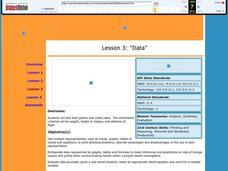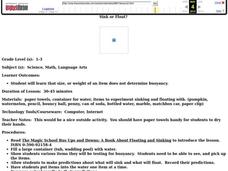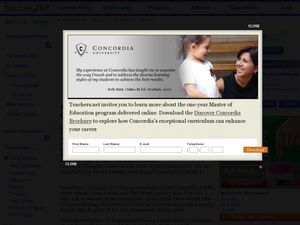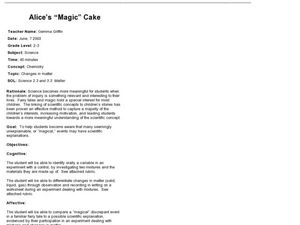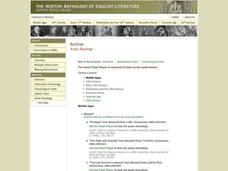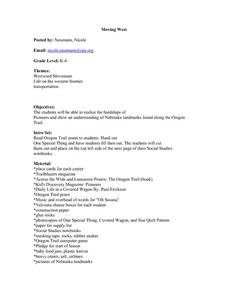Curated OER
Career Awareness
Students discuss career possibilities. In this career education lesson, students view presentations from various career areas and discuss workplace requirements. Students list the top few career choices that interest them.
Curated OER
Author's Purpose
How do you determine an author’s purpose? You ask the author, of course. Invite a local journalist into the class to respond to scripted student questions about his/her writing process. A review of basic classroom etiquette is also...
Curated OER
Kaffee - und Teegesellschaften: German Foods
Introduce your Language students to the culture and 19th century German custom of serving coffee and cake at small parties. They read old cookbooks, sort recipes, prepare foods, compare old German recipes to recipes from home and convert...
Curated OER
Perseverance: Keep Going
Kids evaluate world history events that show perseverance by creating artistic images. They investigate historic photographs and images which conjure up the feelings of perseverance, then utilize acrylic paints to capture the...
Curated OER
The Internet
Third graders study the White House and the First Family by doing Internet research.
Curated OER
Soil's Secret
Students examine two types of soils in their area. They identify its texture and permeability to determine its origin. They share their results with the class.
Curated OER
Sing! Sing a Song!
Students investigate climate change. They read and listen to an environmental song or a song about change or taking action. Students write, sing, and record their own song about climate change.
Curated OER
Events and Effects of World War I
Ninth graders explore the main events, key people, outcomes and lasting effects of World War I. They research the lasting effects of World War I on the 20th Century and discuss the Treaty of Versailles and its effects on Germany.
Curated OER
Property Lists for Quadrilaterals
Young scholars establish classifications of shapes by various properties (angles, sides, etc.). They introduce the important properties of common shapes. Students develop an awareness of the wide variety of ways the 2-D shapes can be alike.
Curated OER
Dictionary Guide Words: How Do They Guide Us?
Fourth graders, after brainstorming what the word "guide" means, examine how to use guide words in a dictionary to locate words. They define "guide," identify guide words in a variety of dictionaries and locate words using guide words....
Curated OER
Data
Students collect data from an experiment they perform. In this data lesson, students use multiple representations to solve practical problems; describe advantages and disadvantages of the use of each representation. Then, they evaluate...
Curated OER
Sink or Float?
Students predict and test different items to see if they sink or float. For this sink and float lesson plan, students predict whether an item is buoyant or not, and learn that size and weight do not matter when it comes to buoyancy.
Curated OER
Irony in Poetry and Prose (Fiction and Non-fiction Texts)
Middle and high schoolers examine the impact of irony in poetry and prose. In this figurative language lesson, they read instructor-selected literature and identify uses of irony. Then they discuss how irony enhances literature.
Curated OER
Civil Rights: Rosa Parks Centers
Research the Montgomery Bus Boycott and Rosa Parks. Set up different centers and have learners rotate through the activities aimed at researching Rosa Parks. They read The Bus Ride that Changed History: The Story of Rosa Parks, write a...
Curated OER
Alice Magic Cake
Using a famous children's story as the hook, learners explore the concept of changes in matter. First, they make a cake similar to the one made by Alice in the story Alice's Adventure in Wonderland by Lewis Carroll. Next, they let their...
Curated OER
Friction: Friend or Foe?
Using a hands-on approach, learners explore the effect of friction on objects. Learners use toy cars, shoes, wood, metal, and more to experiment with the causes and effects of friction. Afterwards, they conduct experiments in which they...
Curated OER
Oil Well That Ends Well
Focusing on the effect of oil spills on the environment, learners conduct experiments to explore this issue. First, they create an ocean environment using materials provided. Then, they make a simulated crude oil substance from vegetable...
Illustrative Mathematics
Quinoa Pasta 1
Here is a great opportunity to introduce your mathematicians to a food they may never have heard of, quinoa. It may help to show a short video on quinoa, or make some quinoa for the class to try. Once they get over how to say quinoa,...
Curated OER
Napolean Triangle
Students investigate the Napoleon triangle theory. In this polygon lesson, students differentiate between the boundary points, interior and lattice point of a polygon. They apply concepts of equilateral triangles to solve...
Curated OER
Social and Cultural Issues in the Civil Rights Movement
Students watch videos, listen to speeches and analyze the information that is presented about the civil rights movement. They examine visual art of the period.
Curated OER
Letters from the Heart: Designing for the Other 90% of the World's Population
Students explore varied aspects of the design process and learn that most products are designed to reach the worlds wealthiest 10%. For this lesson, students work in groups to learn ways in which designers are attempting to rectify this...
Curated OER
Time Line of Astronomy Events and Discoveries
Students work in groups to present a segment of a timeline of events and discoveries in astronomy. In this astronomy lesson plan, students teach their classmates about their section of the timeline.
Curated OER
Moving West!
Students explore, explain and experience the importance of good character traits in everyday life by assessing the challenging journeys traveled on the Oregon Trail. They study the daily accounts of perseverance and courage along the trail.
Curated OER
The Mathematical Implications of Lying
Students explore how statistics can be interpreted in different ways. In this probability instructional activity students complete a class lab activity then discuss their findings.










